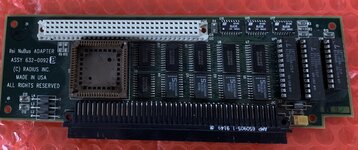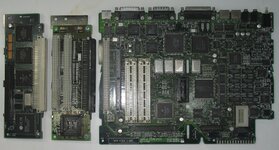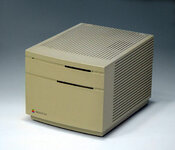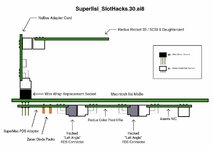demik
Well-known member
The Radius NuBus riser has been reversed. It consists of 3 GALs and a bunch of 74LS Chips. JEDEC for the GALs are here :
 wiki.pldarchive.co.uk
wiki.pldarchive.co.uk

Are the schematics for the adapter available as well? The GAL content is required but not sufficient to replicate the '030 bus -> NuBus adapter.The Radius NuBus riser has been reversed. It consists of 3 GALs and a bunch of 74LS Chips. JEDEC for the GALs are here :
Radius Macintosh IIsi Nubus Adapter - PLD Archive
wiki.pldarchive.co.uk
module GAL20V8A_U12 (
// unused nc1
input i2,
input i3,
input i4,
input i5,
input i6,
input i7,
input i8,
input i9,
input i10,
input i11,
input i13_n,
input i14,
output o15,
output o16,
output o17,
output o18,
output o19,
(* NOREDUCE = "TRUE" *) inout f20,
(* NOREDUCE = "TRUE" *) inout f21,
output o22,
input i23
);
assign o22 = ((i2 | i3 | (~i4) | i13_n) & ((~i2) | (~i3) | (~i4) | i5 | i13_n) & ((~i2) | i3 | (~i4) | (~i5) | i13_n));
assign f21 = ((~i11)) ? ((i2 | i3 | i4 | i5 | i6 | i7 | i9) & (i2 | (~i3) | i6 | i7 | i9) & ((~i2) | i3 | i5 | i6 | i7 | i9) & (i2 | i3 | i23 | i4 | i5 | i6 | (~i9) | (~i14)) & (i2 | (~i3) | i23 | i6 | (~i9) | (~i14)) & ((~i2) | i3 | i23 | i5 | i6 | (~i9) | (~i14)) & (f21 | i8)) : 'bZ;
assign f20 = ((~i11)) ? ((i6 | i7 | i9) & (i23 | i6 | (~i9) | (~i14)) & (f20 | i8)) : 'bZ;
assign o19 = ((i2 | i3 | i4) & (i2 | (~i3) | i4) & ((~i2) | i3 | i4) & ((~i2) | (~i3) | i4 | i5));
assign o18 = ((i2 | (~i3) | i5) & (i2 | i3 | i4 | i5));
assign o17 = ((~i7)) ? i9 : 'bZ;
assign o16 = ((~i7)) ? (((~i2) & (~i3) & (~i5)) | (i2 & (~i3) & (~i5)) | (i2 & i3 & i4 & (~i5)) | (i2 & (~i3) & (~i4) & (~i5)) | (i2 & i3 & (~i4) & (~i5))) : 'bZ;
assign o15 = (((~i7) | i14) & ((~i10) | i13_n));
endmodule // GAL20V8A_U12module GAL20V8A_U13 (
input CLK,
input i2,
input i3,
input i4,
input i5,
input i6,
input i7,
input i8,
input i9,
input i10,
input i11,
input OE_n,
input i14,
input i15,
(* NOREDUCE = "TRUE" *) inout f16,
// unused o17,
output o18,
(* NOREDUCE = "TRUE" *) inout rf19,
// unused o20,
(* NOREDUCE = "TRUE" *) inout rf21,
inout f22,
input i23
);
reg rf19_reg = 'b0;
reg rf21_reg = 'b0;
assign f22 = ((~i23) | (~i15) | (~i14));
always @(posedge clk) begin
rf21_reg <= (((~rf21) | rf19) & (rf21 | (~i11)));
end
assign rf21 = (~(OE_n)) ? rf21_reg : 'bZ;
// o20 OE signal is grounded
always @(posedge clk) begin
rf19_reg <= ((i2 | i3 | (~f22) | (~i4) | (~rf21) | i5 | (~i6) | (~rf19) | (~i7) | (~i8) | (~i9) | (~i10)) & (i2 | (~rf21) | (~rf19) | i7 | (~i8) | i9 | (~i10)));
end
assign rf19 = (~(OE_n)) ? rf19_reg : 'bZ;
assign o18 = rf19;
// o17 OE signal is grounded
assign f16 = (rf19 & (i2 | f16));
// i15 OE signal is grounded
endmodule // GAL20V8A_U13module GAL16V8A_U14 (
input CLK,
input i2,
input i3,
input i4,
input i5,
input i6,
input i7,
input i8,
input i9,
input OE_n,
(* NOREDUCE = "TRUE" *) inout rf12,
inout f13,
output o14,
(* NOREDUCE = "TRUE" *) inout f15,
(* NOREDUCE = "TRUE" *) inout f16,
output o17,
output o18,
inout f19
);
reg rf12_reg = 'b0;
assign f19 = (rf12 | i6);
assign o18 = ((~i2)) ? (~'b0) : 'bZ;
assign o17 = (((~i2) | f15) & (f16 | (~i7)));
assign f16 = (((~i4) | (~f15) | i8 | (~i9)) & (i3 | f16 | (~i9)));
assign f15 = (((~f13) | (~i9)) & ((~i5) | f15 | (~i9)) & (f15 | i8 | (~i9)));
assign o14 = ((~f19) & i4 & (~i5) & (~f16));
assign f13 = ((~i2) & (~f19) & (~i4) & i9);
always @(posedge clk) begin
rf12_reg <= (~rf12);
end
assign rf12 = (~(OE_n)) ? rf12_reg : 'bZ;
endmodule // GAL16V8A_U14 68kmla.org
68kmla.org
 68kmla.org
68kmla.org
Not sure about the equations involving registered I/Os (names starting in 'r'), they likely should use the register (that has _'reg' appended in the verilog) rather than the I/O wire as an input. Someone more knowledgeable on GALs would know how to interpret the meaning more accurately.edit: Nice work @Melkhior
Like I said in the Macintosh II Sadness thread, have a look at Apple's NuBus primer:Now considering having a got at the NuBusFPGA, so interested in NuBus. I don't have a IIsi so understanding what's needed for a '030 bus -> NuBus adapter is purely intellectual curiosity at this stage
I have all the relevant PDFs and a paper copy of the 3rd edition on the way ;-) Currently hesitating to have the (very) expensive design manufactured - I have a simulation telling me if the hardware works I should be able to talk to the NuBus, but I'm not sure about all the critical bits (interfacing the CPLD/FPGA/driver chips to the NuBus & the VGA/HDMI stuff) being well designed schematics-wise... and anyway with CNY coming up there's no point in ordering anything before mid-february. And all the chips might not be available anyway with the ongoing shortage (I've had to fix a few references already, but more keep disappearing). And quite expensive just to figure out if can be made to work - last time I checked, a couple of boards would set me back close to 600€ once the custom duty is taken into account...Like I said in the Macintosh II Sadness thread, have a look at Apple's NuBus primer:

Per DuoDock implementation, add second NuBus Slot to adapter with a PDS passthru atop for 030 NIC? Do it up right with three NuBus Slots and a Passthru that's either/or by sharing the Top NuBus Slot's interrupt?| NuBus Adapter/FPU | TwinSlot PDS Adapter | Isi Logic Board |
NuBus Slot $9/FPU -> top PDS Slot -> Bottom PDS = Improved/Rearranged IIci Application Specific Cache Slot -> IIsi Logic Board
NuBus Adapter in Top Slot is connected to Bottom Slot on TwinSlot adapter PCB used in blockish TXT diagram for "clarity" LOL!
IIci down two NuBus Slots and IIsi down Audio IN subsystem, but machine state = IIci ROM boot? = IIxi

Is that a new/current pic? Please tell me you are going to recap that board soon. Note the PDS adapter has a nasty leaky cap too.Meanwhile, I located the SuperIIsi™ project box. Promised pic:

Thinking about it, SuperMac riser is for a max size SE/30 VidCard. What might the differentiation between IIsi and SE/30 PDS slots be for them to have made provision for those packs?I've since learned that what I thought were noise reducing Zener Diodes should be labeled Resistor Packs (for bus termination?) on the SuperMac VidCard adapter. My adapters don't have packs installed, but I've seen pictures of same where they were installed. Those were orange as depicted, is there a color coding standard for SIP components.
We had @joethezombie saying he hated us for having been roped into buying it by the third post of that 249 reply PM thread!Hey Trash,
Thought you might find this interesting - a IIsi nubus adapter made by radius (not apple), with FPU unpopulated. Perhaps this is a path to nubus on SE/30?
 68kmla.org
68kmla.org
